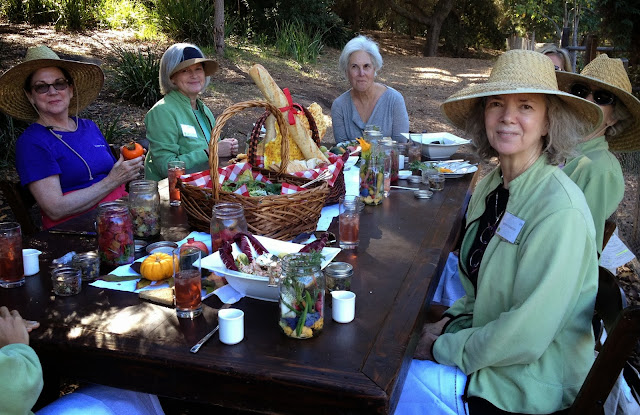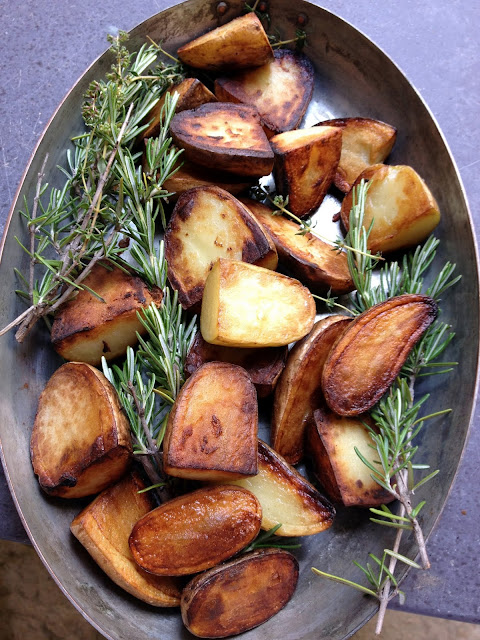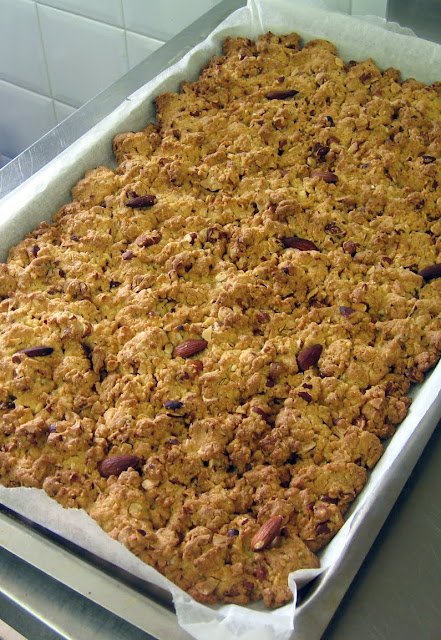This week I have been fortunate enough to participate in Nutritious Life Week at the Golden Door Spa in Escondido, California. Along with 5-mile morning mountain hikes, classes in Fast Fit, daily workouts with my trainer, strenuous water aerobic classes, and daily tennis lessons, the days are sprinkled with massages, manicures, pedicures and facials. There is also time for me to talk to the guests about my own fitness program, my cooking, and signings for my new book, The French Kitchen Cookbook. Pictured above are a few guests enjoying the spa's first outdoor picnic, held overlooking the 3-acre organic vegetable garden, a paradise that right now is bursting with multiple varieties of beets, carrots, fennel, kale, society garlic, nasturtiums, oregano, and Mexican tarragon. Tonight, in our cooking class, we sliced many of these vegetables paper-thin, blanched them, then tossed them with an avalanche of herbs and a Yogurt, Lemon and Chive Dressing (recipe follows.) We also prepared a lighter variation of my Miniature Onion and Goat Cheese Appetizers, as well as Grilled Polenta Squares with Tomato and Onion Sauce, both variations on recipes from The French Kitchen Cookbook.
Yogurt, Lemon, and Chive Dressing
Equipment: A small jar, with a lid.
2 tablespoons freshly squeezed lemon juice
1/2 teaspoon fine sea salt
1/2 cup plain, low-fat yogurt
1/3 cup finely minced fresh chives
In a small jar, combine the lemon juice and the salt. Shake to dissolve the salt.
Add the yogurt and chives. Shake to blend. Taste for seasoning. Store covered and refrigerated, for up to 1 week. Shake to blend again before using.
About 3/4 cups
Miniature Onion and Goat Cheese Appetizers
These tasty, savory, miniature appetizers are a huge hit in my cooking classes. There is always a great sense of satisfaction, when one removes a tray of these fragrant, golden nuggets from the oven. These are best warm from the oven but are also delicious at room temperature. They can serve as appetizers or as sides to a simple green salad.
Equipment: A food processor; 2 nonstick petit four molds or mini muffin tins, each with twelve 2 1/2–inch (6.5 cm) cups, or a 24-cup mini-muffin pan.
4 tablespoons extra-virgin olive oil
1 pound (500 g) onions, peeled, halved lengthwise, and cut into thin half moons
Fine sea salt
Coarse, freshly ground black pepper
4 ounces (125 g) soft, fresh goat’s milk cheese
Grated zest of 1 lemon, preferably organic
3 large eggs, preferably free range and organic lightly beaten
1 teaspoon fresh lemon thyme or regular thyme leaves
Fleur de sel, for garnish
- Evenly center two racks in the oven. Preheat the oven to 400°F (200°C).
- In a skillet, heat the oil over moderate heat until hot but not smoking. Reduce the heat to low, add the onions and a pinch of salt, and sweat – cook, covered, over low heat until soft and translucent – about 10 minutes. Season generously with freshly ground black pepper. Taste for seasoning.
- In the food processor, combine the goat cheese, lemon zest, eggs, and thyme leaves and process to blend. Add the cheese mixture to the onions in the skillet and stir to blend. Taste for seasoning.
- Spoon a tablespoon of the mixture into each mold or muffin cup.
- Place the molds in the oven and bake until the mixture is golden, 20 to 25 minutes. Remove from the oven and let cool slightly. Then remove them from the cups. Serve warm or at room temperature, sprinkled with fleur de sel.
Makes 24 miniature appetizers
Wine suggestion: The mineral-rich flavors of this blend of Marsanne, Clairette, Ugni Blanc and Bourboulenc with their touch of spice make this white wine –Domaine du Paternel Cassis Blanc de Bancs -- a perfect palate opener to pair with the tatins.
Grilled Polenta with Tomato and Onion Sauce
This light, colorful vegetarian weeknight dinner is a favorite, and this soothing, comfort-food dish knows few rivals, particularly in cooler weather.
Equipment: A 1-quart (1 l) gratin dish, 4 warmed dinner plates.
3 1/2 cups (875 ml) 1 % milk
Fine sea salt
1/2 teaspoon freshly grated nutmeg
3/4 cup (135 g) instant polenta
1/2 cup (3 ounces; 90 g) freshly grated Gruyère cheese, plus extra for garnish
1 large onion, peeled, halved lengthwise, and cut into thin half-rounds
2 tablespoons extra-virgin olive oil
2 fresh or dried bay leaves
One 28-ounce (765g) can peeled Italian plum tomatoes in juice
Fresh, flat-leafed parsley leaves, for garnish
1. In a large saucepan, bring the milk, 1 teaspoon of the sea salt, and the nutmeg to a boil over medium heat. (Watch carefully, for milk will boil over quickly.) Add the polenta in a steady stream and, stirring constantly with a wooden spoon, cook until the mixture begins to thicken, about 3 minutes.
2.Remove from the heat. Add half of the cheese, stirring to blend thoroughly. The polenta should be very creamy and pourable. Pour it into the gratin dish. Even out the top with a spatula. Sprinkle with the remaining cheese. Let sit at room temperature for about 30 minutes to firm up. (Or store, covered and refrigerated, for up to 3 days.)
3.Prepare the tomato garnish: In a large skillet, combine the onion, the olive oil, and 1/2 teaspoon of the sea salt and sweat – cook, covered over low heat until soft and translucent – about 5 minutes. With a large pair of scissors, cut the tomatoes in the can into small piece. Add the bay leaves and tomatoes and their juices and cook, covered, over low heat for about 15 minutes. Taste for seasoning.
4.At serving time, preheat the broiler. Cut the polenta into 8 even squares. Place on the baking sheet, cheese side up. Place under the broiler and broil until the cheese sizzles, 1 to 2 minutes. Transfer the squares to the warmed plates, stacking the second slice at an angle over the first. Spoon the sauce all over. Garnish with parsley and cheese.
4 servings
WINE SUGGESTION: An inexpensive everyday dish suggests an equally fine but gently priced wine. A favorite is Michel and Stephane Ogier’s La Rosine Syrah, a deep purple vin de pays from the hillsides north of the old Roman town of Vienne.
MAKE AHEAD NOTE: Both the tomato sauce and the polenta can be prepared up to 3 days in advance, then covered and refrigerated separately. Reheat at serving time.
THE SECRET: When using whole, canned tomatoes, use a scissors to cut the tomatoes into small pieces, making for a still chunky yet finer sauce.










